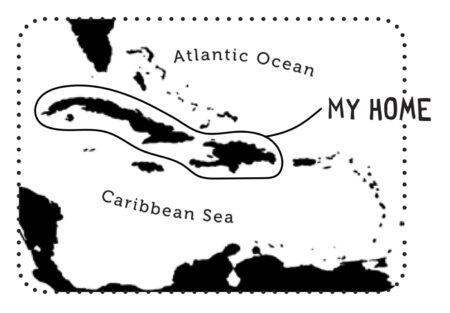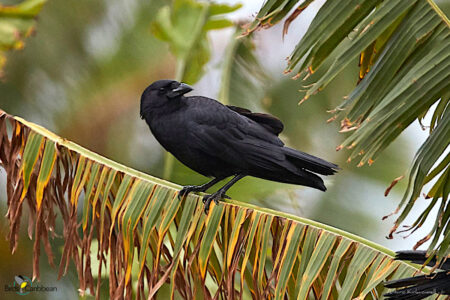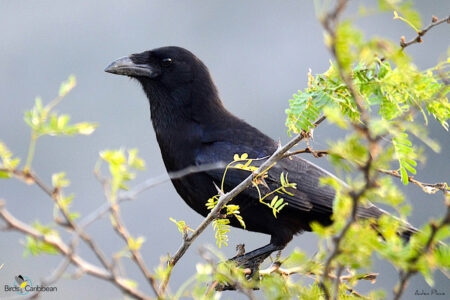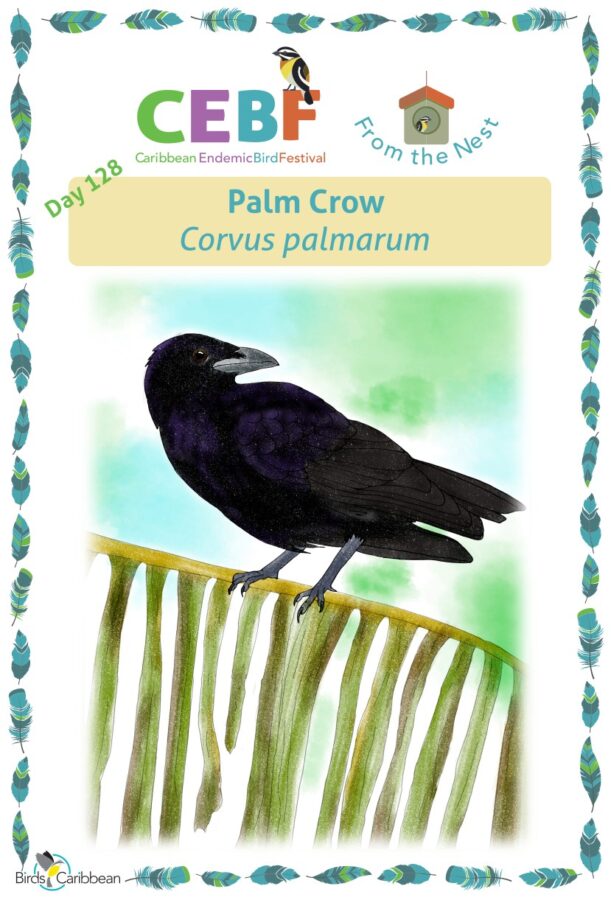Celebrate the Caribbean Endemic Bird Festival (CEBF) with us! Our theme in 2023 is “Water: Sustaining Bird Life” highlighting the importance of water conservation to both humans and birds. Have fun learning about a new endemic bird every day. We have colouring pages, puzzles, activities, and more. Download for free and enjoy nature with your family at home.
Endemic Bird of the Day: Palm Crow
 A crow that lives on palm trees? Well, yes…, but the name can be misleading. Palm Crow (Corvus palmarum) can also be found in high-elevation pine forests, lowland and swampy forests, dry plains, and cultivation areas. Restricted to the islands of Cuba and Hispaniola, there is a recent proposal for separating them into two different species. This could have a profound effect on its conservation status, given that the Cuban subspecies is very rare and confined to just a few localities.
A crow that lives on palm trees? Well, yes…, but the name can be misleading. Palm Crow (Corvus palmarum) can also be found in high-elevation pine forests, lowland and swampy forests, dry plains, and cultivation areas. Restricted to the islands of Cuba and Hispaniola, there is a recent proposal for separating them into two different species. This could have a profound effect on its conservation status, given that the Cuban subspecies is very rare and confined to just a few localities.
This bird is one of the four resident species of crows in the Caribbean. All of them show the classic black plumage with purple-blue iridescence, that people associate with crows and their spooky reputation. They are gregarious, often found in small flocks. Cuban Crow and Palm Crow are almost indistinguishable, a fact that poses an identification challenge for every birder.
Fortunately, they have unique vocalizations. The song of the Palm Crow is a harsh nasal “craaa, craaa,” that resembles the North American Fish Crow (Corvus ossifragus), while the song of the Cuban Crow resembles parrot calls or a gobbling turkey. The Palm Crow also has the well-developed nasal bristles covering nostrils that distinguishes crows from other small blackbirds. The Cuban subspecies is slightly smaller and duller than the one living in Hispaniola.
The Palm Crow’s short, stout, sharp-pointed black bill allows it to devour a variety of food items from fruits to invertebrates. Another important clue for identifying this species is that it can be found frequently feeding on the ground, sometimes near roads, contrasting with its other Caribbean relatives that rarely leave the tree tops.
We know very little about the Palm Crow´s natural history, especially its breeding biology. Pairs build the typical crow nest consisting of a platform made of sticks and lined with dry grasses and other soft materials, located among tree branches or at the base of palm fronds (here is where its name comes from!). They are presumably solitary nesters that defend an exclusive territory, but small groups of up to six individuals can be seen together when mobbing or harassing potential predators away. In Cuba, the breeding season takes place from March through July, and they usually lay three to four pale green eggs spotted in brown and dark olive.
Crows are the quintessential “spooky” birds, considered omens of bad luck when seen. But we can change that undeserved reputation to omens of habitat quality and protection. Half of our Caribbean crows are threatened, and Palm Crow, even though it is not globally threatened, is protected and considered Endangered in Cuba. The forests they inhabit are being lost to agriculture and human development all across their range. Even in Hispaniola, where they are more common and widespread, their numbers have decreased recently. A lack of long-term data on population trends hinders us from making a clear assessment of the species’ status.
So, the next time you see a crow in its habitat, rest assured it is not a sign of foreboding, but rather an indication of a healthy patch of conserved forest. Learn more about this species, including its range, photos, and calls here.
Thanks to Daniela Puerto for the text!
Colour in the Palm Crow
Download our West Indies Endemic Bird colouring page. Use the photos below as your guide, or you can look up pictures of the bird online or in a bird field guide if you have one. Share your coloured-in page with us by posting it online and tagging us @BirdsCaribbean #CEBFfromthenest
Listen to the calls of Palm Crow
The calls of the Palm Crow are a flat, harsh “raaah.”
Puzzle of the Day
Click on the image below to do the puzzle. You can make the puzzle as easy or as hard as you like – for example, 6, 8, or 12 pieces for young children, all the way up to 1,024 pieces for those that are up for a challenge!


Activity of the Day
 FOR KIDS: This year the theme for the festival is “Water: Sustaining Bird Life.” Birds need water just as much as we do. Water is important both for drinking and as a source of food for birds. It also keeps birds clean and cool on hot days when they take a splish-splash in a puddle, gutter, or backyard bird bath. Many birds also rely on wetland habitats, such as our ponds, salinas, marshes, mangroves, rivers, and coastal waters. With growing human populations and relentless development, there are growing demands for water and continued destruction of our remaining wetlands.
FOR KIDS: This year the theme for the festival is “Water: Sustaining Bird Life.” Birds need water just as much as we do. Water is important both for drinking and as a source of food for birds. It also keeps birds clean and cool on hot days when they take a splish-splash in a puddle, gutter, or backyard bird bath. Many birds also rely on wetland habitats, such as our ponds, salinas, marshes, mangroves, rivers, and coastal waters. With growing human populations and relentless development, there are growing demands for water and continued destruction of our remaining wetlands.
Pollution, erosion, and prolonged droughts are also directly impacting the quantity and quality of water resources and habitats available both for our birds and ourselves!
How much do you know about saving water and making sure we don’t waste this precious resource? Test you knowledge in our ‘Water IQ’ quiz. If you need some help with the answers you can search online- you could try here as a starting point for tips of water conservation.
Completed the quiz? You can check your answers here.
FOR KIDS AND ADULTS: Enjoy this video of a Palm Crow in Cuba. You can hear the birds rasping calls to each other in the background.


One comment
Comments are closed.